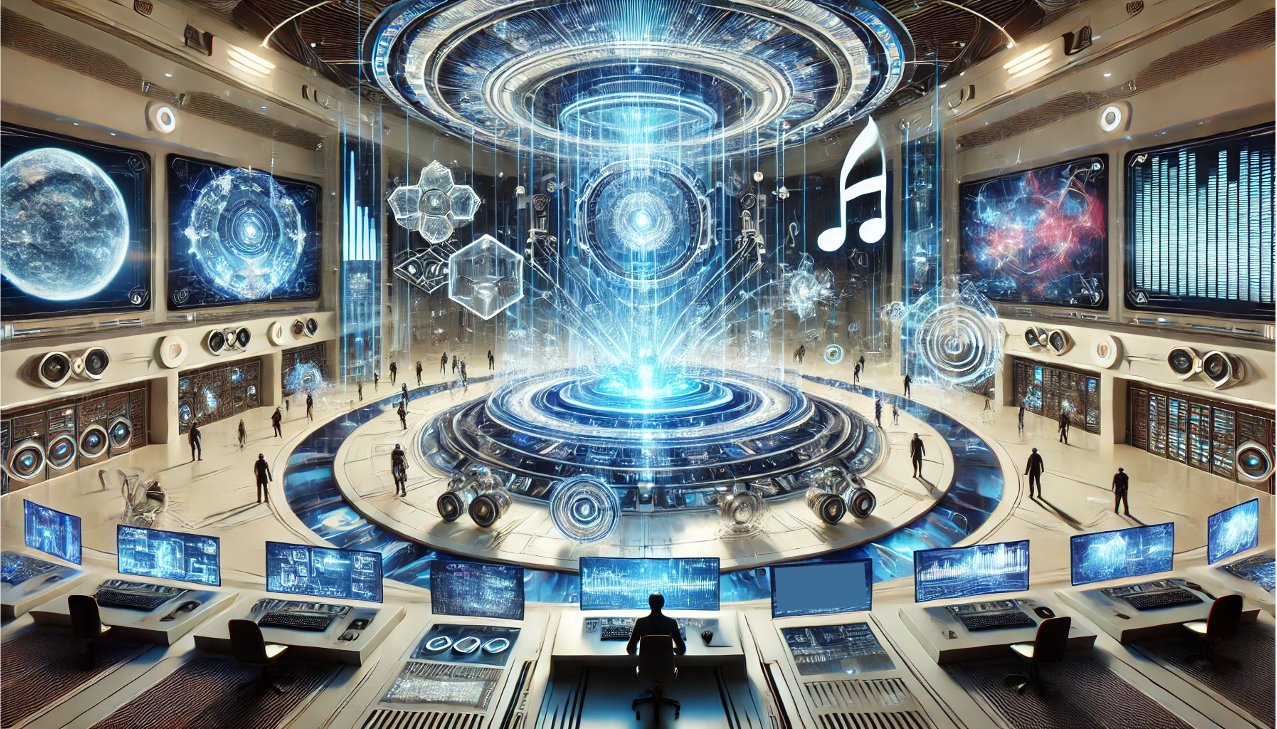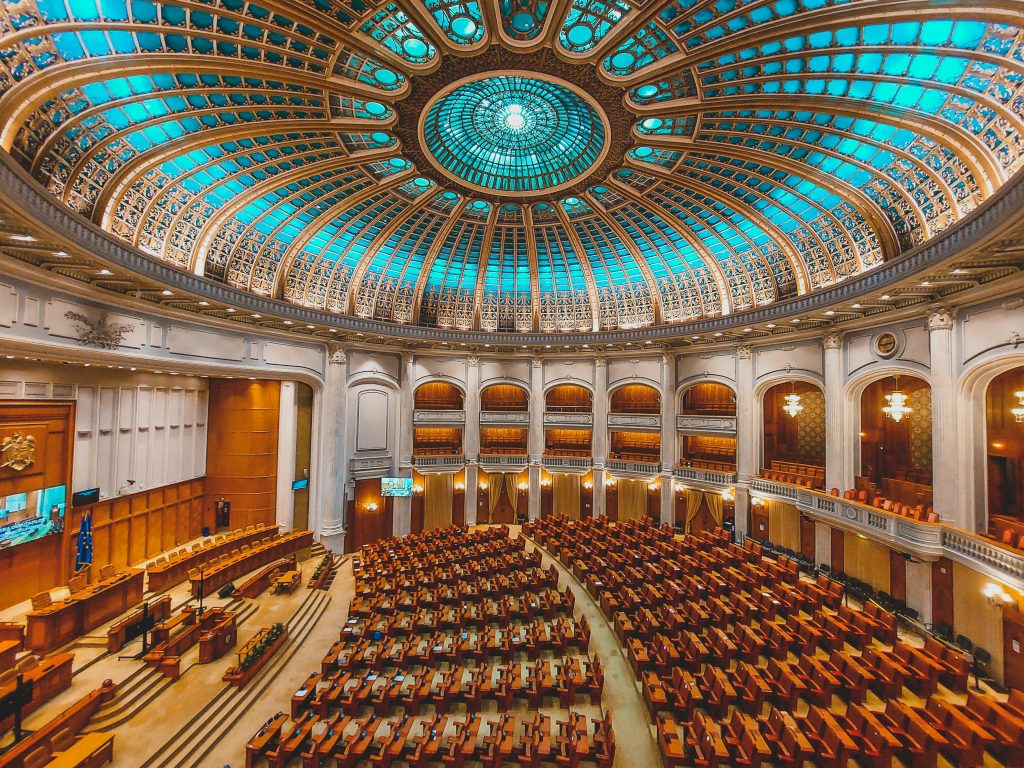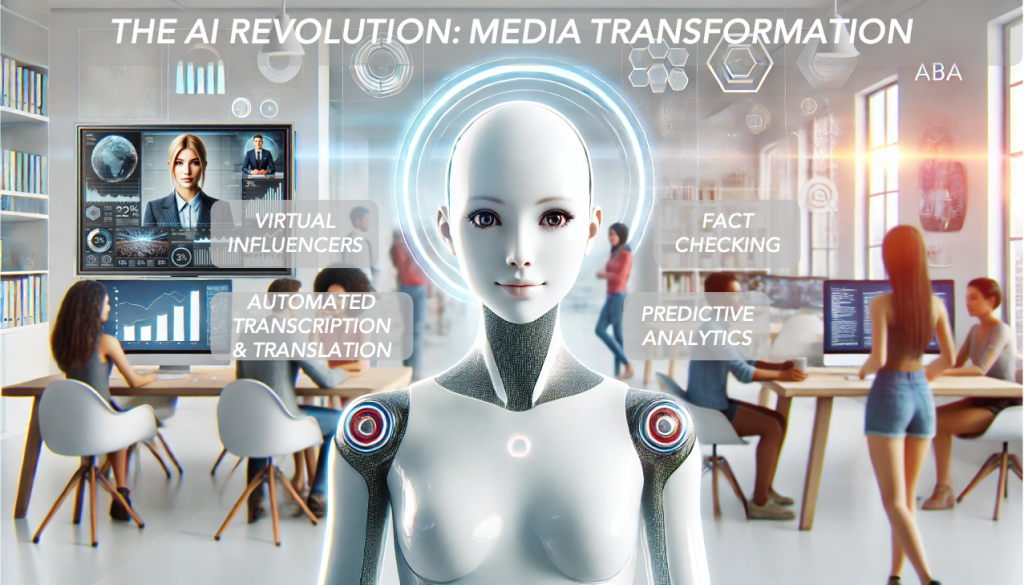
Blog Contents
Spoiler alert: An AI helped write this blog about AI in entertainment. It’s like a cameo
appearance, but for algorithms! We tried to teach it a knock-knock joke, but it kept replying
“Who’s there? Data.” Clearly, we humans still corner the market on comedy. For now.
In our journey through the AI revolution, we’ve explored how artificial intelligence is
transforming media and reimagining publishing. Now, we turn our attention to perhaps the
most exciting frontier: entertainment. From the silver screen to the gaming console, from
the recording studio to the streaming platform, AI is becoming the ultimate creative partner,
pushing the boundaries of what’s possible in storytelling and audience engagement.
This third installment in our four-part series on “The Generative AI Revolution in Media,
Publishing, and Entertainment” delves into how AI is reshaping the entertainmentlandscape. We’ll explore its impact on film and television, gaming, and music, uncovering
how this technology is not just changing how we consume entertainment, but how we
create and interact with it. Welcome to the future of entertainment, where the only limit is
our imagination – and our AI’s processing power.
AI-Generated Screenplays: The New Writing Room
The blank page – the eternal nemesis of writers everywhere – may have met its match in AI.
Tools like ScriptBook and Jasper AI are pushing the boundaries of narrative creation,
generating original screenplays and offering plot suggestions that challenge and inspire
human writers.
Take, for instance, the case of “Sunspring,” a short film written entirely by an AI named
Benjamin (using GPT-3 technology). While the resulting script was surreal and at times
nonsensical, it demonstrated AI’s potential to generate unique narrative structures and
dialogue. More practically, ScriptBook’s AI has been used to analyze screenplays and predict
box office performance with 86% accuracy, potentially revolutionizing how studios choose
which projects to greenlight.
These AI writing assistants aren’t replacing human creativity; rather, they’re augmenting it.
They can help break writer’s block, suggest unexpected plot twists, or even generate entire
storylines that human writers can then refine and develop.
Deepfake Technology in Visual Effects: The New Frontier of Digital Actors
Deepfake technology, often controversial in other contexts, is finding a home in Hollywood’s
visual effects departments. Tools like DeepFaceLab and FaceSwap are opening up new
possibilities for filmmakers, from de-aging actors to creating entirely new digital
performances.
Marvel Studios, for example, used deepfake-like technology to de-age Samuel L. Jackson in
“Captain Marvel,” creating a seamless younger version of the actor. In a more experimental
vein, the documentary “Welcome to Chechnya” used AI-generated faces to protect the
identities of at-risk individuals while still preserving their facial expressions and emotions.
This technology is not just about visual trickery; it’s about expanding the palette of
storytelling tools available to filmmakers. It allows for the creation of performances that
would be impossible or impractical to capture through traditional means, potentially
ushering in a new era of digital acting.
Automated Content Moderation: The Invisible Guardians of Streaming
As streaming platforms proliferate, the challenge of content moderation grows
exponentially. AI systems like Clarifai and Amazon Rekognition are becoming the first line of
defense, analyzing vast amounts of video content to flag potentially problematic material.
Netflix, for instance, uses AI-powered content moderation to scan thumbnails and video
frames for inappropriate content. This allows them to maintain platform standards across a
vast and constantly growing library of content, ensuring a safe viewing experience for users
of all ages.
These AI systems are not just about restriction; they’re also enabling more nuanced content
rating systems. By analyzing context and content in detail, AI can provide more accurate and
granular content warnings, allowing viewers to make more informed choices about what
they watch.
Procedural Content Generation: Endless Possibilities in Game Design
The days of static, pre-designed game worlds are numbered. AI-powered procedural content
generation is creating vast, dynamic game environments that are unique for each player.
Tools like Houdini and Unity’s WaveFunctionCollapse are at the forefront of this revolution.
No Man’s Sky, a game featuring an entire procedurally generated universe, showcases the
potential of this technology. Using AI algorithms, the game generates 18 quintillion planets,
each with unique flora, fauna, and geological features. This not only creates a sense of
endless exploration but also dramatically reduces development time and resources needed
for world-building.
Procedural generation isn’t limited to environments. AI can create quests, characters, and
even entire storylines, ensuring that no two playthroughs are exactly alike. This technology is
transforming games from finite experiences into ever-evolving worlds.
Dynamic Difficulty Adjustment: The AI That Knows Just How to Challenge You
Gone are the days of static “Easy,” “Medium,” and “Hard” difficulty settings. AI systems like
TrueSkill and the technology behind Psyonix’s skill-based matchmaking are creating dynamic
difficulty systems that adapt in real-time to each player’s skill level.
For example, the racing game Forza Motorsport uses AI to analyze player performance and
subtly adjust the behavior of AI-controlled opponents. If a player is struggling, the AI mightmake opponents slightly less aggressive; if a player is dominating, it might ramp up the
challenge. This creates a constantly engaging experience that keeps players in their “flow
state.”
These systems are not just about making games easier or harder; they’re about creating
perfectly tailored experiences that keep players engaged and challenged, regardless of their
skill level.
AI-Powered NPCs: Bringing Game Worlds to Life
Non-Player Characters (NPCs) are the supporting cast of the gaming world, and AI is making
them smarter and more lifelike than ever. Platforms like Spirit AI and Inworld AI are creating
NPCs that can engage in natural conversations and exhibit complex behaviors.
In the game “Shadow of Mordor,” the Nemesis System uses AI to create unique enemy
characters that remember past encounters with the player and adapt their behavior
accordingly. This creates a sense of a living, responsive world where every interaction
matters.
As these AI systems become more sophisticated, we’re moving towards game worlds
populated by characters that feel truly alive, with their own goals, memories, and
personalities. This deepens player immersion and opens up new possibilities for storytelling
in games.
AI-Assisted Composition: The New Music Theory
AI is becoming an invaluable tool in the composer’s arsenal. Platforms like AIVA (Artificial
Intelligence Virtual Artist) and Amper Music are not just generating background music;
they’re creating complex, emotionally resonant compositions.
AIVA, for instance, has been credited as a composer on several albums and has even created
music for film trailers. In 2016, AIVA became the first AI to be recognized as a composer by a
music society (SACEM), highlighting the growing acceptance of AI in the creative process.
These AI composers are not replacing human musicians; instead, they’re offering new
avenues for collaboration and inspiration. They can generate musical ideas, suggest chord
progressions, or even create entire backing tracks, allowing human composers to focus on
higher-level creative decisions.
Automated Music Mastering: Democratizing Professional Sound
The final step in music production – mastering – has long been the domain of experienced
professionals with expensive equipment. AI is changing that. Tools like LANDR and iZotope
Ozone use machine learning to professionally master tracks, making high-quality production
accessible to independent artists.
LANDR, for example, has mastered over 10 million tracks since its launch. Its AI analyzes the
song’s genre, instrumentation, and dynamics to apply appropriate processing, often
achieving results comparable to human mastering engineers.
This democratization of professional-quality sound production could lead to a more diverse
and vibrant music scene, where artists can produce release-ready tracks without the need
for expensive studio time.
Personalized Audio Experiences: The Soundtrack of Your Life
AI is also revolutionizing how we consume audio content. Platforms like Endel and Brain.fm
use AI to create personalized soundscapes that adapt to the listener’s environment, activity,
and even biometric data.
Endel, for instance, generates personalized sound environments to help users focus, relax, or
sleep. It takes into account factors like time of day, weather, and the user’s heart rate (if
available) to create a constantly evolving soundscape.
This level of personalization represents a new frontier in audio entertainment. Instead of
passive consumption, listeners can engage with adaptive audio experiences that respond to
their needs and environment in real-time.
As we’ve seen, AI is not replacing human creativity in entertainment; it’s augmenting and
enhancing it. From generating new ideas to creating personalized experiences, AI is
expanding the boundaries of what’s possible in film, gaming, and music.
However, this AI revolution also brings challenges. As we integrate these powerful tools into
our creative processes, we must grapple with questions of authorship, creativity, and the
nature of art itself. How do we maintain the human touch in AI-assisted creations? How do
we ensure that AI-enhanced entertainment doesn’t become formulaic or lose its emotional
resonance?
These are the questions that will shape the future of entertainment in the age of AI. And
they’re questions we’ll continue to explore in the final part of our series, where we’ll delve
into the challenges and ethical considerations of AI in creative industries, as well as
strategies for successfully navigating this new landscape.
Stay tuned for our final installment, “Navigating the AI-Powered Future of Creative
Industries,” where we’ll pull together the threads from our exploration of media, publishing,
and entertainment to look at the big picture of AI in creative fields. The curtain is rising on a
new era of entertainment – and AI is taking center stage.





